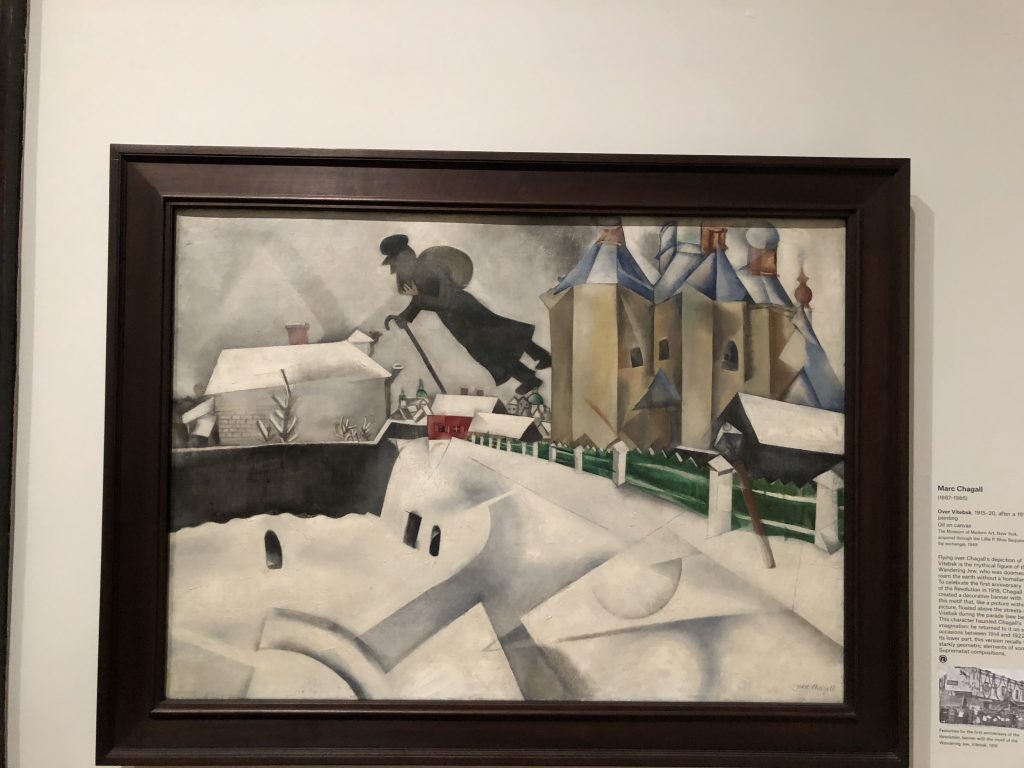
Over Vitebsk-Marc Chagall
This painting was made by Marc Chagall in 1915-20. It is an oil painting on canvas. It’s hung in The Jewish Museum on 92nd Street and 5th Ave. The painting is both abstract and carries a political message. Chagall was a Hasidic Jew who grew up in Russia. He moved out of Russia for a while, but returned to bring his remaining belongings and his wife to Paris, where he had been living. He ended up getting stuck in Russia due to the Revolution, but he remained because he was finally granted rights and full citizenship. Chagall did not always have rights like he did after the Revolution, and this can be depicted in his painting. The name of the painting is “Over Vitebsk.” Featured in the painting is a Hasidic Jew flying over what seems to be Chagall’s hometown in Russia. The painting represents the idea of the “Wandering Jew,” lost without a homeland. The Jew in the picture is depicting the thousands of Jews who had left Russia and Eastern Europe in the days of Chagall’s childhood. Although this painting is abstract and may not be so clear, when I first saw it I knew right away that it had a message. After a few additional minutes of observing it, and reading the placard next to the painting, I was able to see what the message was. Before entering The Jewish Museum I read a brief article about Chagall, “An Art School Started by Marc Chagall that Became a Modernist Wasteland.” From this I knew that life in Eastern Europe was hard for Jews in Chagall’s early years. This helped me create an inference about what the painting was trying to say. I felt that the painting was trying to show how the Jews in Eastern Europe felt, like they didn’t belong. The Jews weren’t always granted equal citizenship, and the painting displays this. The image of the Hasidic Jew fleeing Russia shows that they felt like they didn’t have a place to live; they didn’t have a home. This work is very experimental, because it is sending a major message. It is addressing the issue of the way Jews were being treated in Eastern Europe. I feel that this painting is both a mimesis and abstract. It’s a mimesis in the way that it depicts the Hasidic Jew. I was able to tell right away that the floating figure was a Jew, and I was able to understand what the Jew was representing. Although the painting is a mimesis, it is also abstract because the land is painted in a way that isn’t so clear. I was able infer that the land was Chagall’s hometown in Russia because of the knowledge I had read before, but one wouldn’t be able to tell right away that area the Jew is flying over is in Russia. For me, this painting evoked a lot of emotion. I was able to see that the Hasidic Jew took all of his belongings, got up, and was leaving the place that he grew up in, leaving his home with no destination in mind. I felt upset, sad, and angry that this happens so often in the world. People are constantly being kicked out of their homes, and are being forced to move. This painting was able to send a clear, strong message. I really enjoyed the museum and this piece.

Renee,
You did a great job at explaining what the floating man in this work of art symbolizes. You are right, just by looking at the picture one would not know that it is referring to the mistreatment of the Jews in Russia and symbolizing how the Jews felt out of place and like they had no home. I personally enjoy this work of art because it gives off a wintery-Christmas vibe and reminds me of December, which is my favorite month, so it personally resonates with me because I just find it a nice picture. Additionally, I also feel sad that people are constantly being forced to move away from their homes in this world because of reasons that are out of their hands.
Hi Renee,
In your analysis of the painting, you pointed out many things that I hadn’t noticed at first glance. For instance, I could not tell that the man was a Jew. You gave a good background description of the Hasidic Jew and the struggles they faced in Eastern Europe during this time period. Not being Jewish myself, I am not that familiar with Jewish history, so this was a nice refresher. Your analysis and the painting itself forced me to think deeper about this topic, so thank you!
Great job!